Podcast: Play in new window | Download
Subscribe: Apple Podcasts | RSS
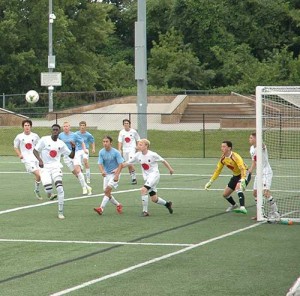 An email came out from US Youth Soccer on Monday, August 24. It was to announce changes that most people had heard something about already.
An email came out from US Youth Soccer on Monday, August 24. It was to announce changes that most people had heard something about already.
The first is that they are mandating small-sided soccer for players below the age of 12. They are also standardizing the formats for each age group. The U8’s will play 4 v 4 without goalkeepers, U9-U10’s will play 7 v 7 and U11 and U12 teams will play 9 v 9. This is a change from the 6 v 6 and 8 v 8 formats that many of the State Associations have been using for years.
The second announcement is a change to the age group cut-offs from August 1st to January 1st. The rest of the world has been using the calendar year age groups for more than twenty years. The funny part of this for me is that the US used calendar year when I start coaching more than 25 years ago but changed to get in line with the rest of the world that was using August 1st to fall in line with school year ages. When we changed to August 1st the rest of the world then switched to calendar year shortly after. Hopefully US Soccer has done more research this time so that this is the final change.
I think that the format change is great. Playing 7 v 7 and 9 v 9 makes a lot more sense than 6 v 6 and 8 v 8 when you look at the way they relate to the full sided game.
I don’t see how the age group changes matter one way or another for 90% of the youth players who will never complete for places on national teams.
The final question I have is when will this start. The changes are mandated for August 2017 but USYS has “encouraged adoption of best practices in August of 2016.” So it looks like it will be on a state-by-state basis which will cause chaos for a year when neighboring states make different decisions. Hopefully each region will be able to agree on how to proceed but that seems unlikely.
This week I finish up my series of episodes on formations for young teams with a look at how the different formations can be used with teams making the transition to the 11 v 11 game.
I’ll review each of the most common systems of play and look at how they can help or hinder developmental goals during this important transition.
11 v 11 Systems of Play for U13’s
When teams begin playing full-sided game it can be a very difficult adjustment. At this age the ball usually changes from a size 4 to a size 5. Also, the fields more than doubles in size but we only add three more players on each team.
These factors totally change the game. In small-sided games one player can take over a game but in the 11 v 11 game the team has to work together to retain possession and create goal scoring opportunities.
This transition is a time when the coach can create a playing environment that encourages the players to see options and make decisions. As I’ve mentioned in the previous two episodes, formations are not the most important factor in your team’s success but they are a framework you can use to train your players to play the game.
Today I’ll discuss each of the most common formations and how they can be used to develop players.
When I’m looking at a formation I’m looking for one that is simple to understand, easy to adjust depending on our players and type of team you’re playing and grants players the freedom and opportunity to make decisions.
I think using multiple formations is important for players because it helps them to understand different systems and ways of playing. The more experiences we give them the more well-rounded they will be.
All formations have strengths and weaknesses. They are just a tool to organize the players and like any tool they can be used to build or destroy.
4-3-3
In my opinion this is the most flexible system. There is a lot of room for player rotation. This has become the most popular ‘base’ system. Your players will likely play in some variation of this system in the future so it is a good one to introduce.
Strengths
- Solid back four
- Three players in the center of midfield
- Most modern formations have three in the middle
- Three attackers
- Covering the width of the field
- Keep opponent’s defenders pinned back
- Space for defenders to get forward
- Easy to open up and play out of the back
- Midfield can be adjusted to suit players and the game
- 1-2
- 2-1
- Free Rotation
Weakness
- Get outnumbered in wide areas
- Center Striker can become isolated if wide attackers drop back to win the ball
- Only one option in the box for crosses
Application for Young Players
- This is the system the Dutch used in the 70’s to create Total Football
- Requires players to move to create options
- Players changing positions
- Midfield
- Gives defenders attacking opportunities
- Space to create 1 v 1’s on the wings
- Easy to rotate wide defenders and wide forwards
4-5-1
This is very similar to 4-3-3 formation. You are just pulling the wide forwards back into midfield.
Strengths
- Very solid defensively
- Wide area are now defended
Weakness
- Isolated forward
- Asks them to hold the ball and bring players into the game
- Young players can become impatient and go on their own
- Out run their support
Application for Young Players
- In my opinion this is a fearful 4-3-3
- It compacts the field
- Makes it hard to get forward
- Need a strong target to hold the ball
4-2-3-1
You might look at this as just another 4-5-1. The difference is the freedom given to the three attacking mids and forward by the presence of two holding midfielders.
Strengths
- Clear distinction between back 6 and front four
- Holding mids create screen for defenders
- Frees up outside backs to attack with confidence
- Closer support for forward
- Creates wingers out of outside mids
Weakness
- Getting holding Mids to hold
- A bit more complicated
- Still have isolated forward
Application for Young Players
- This will take time for the players to understand
- There are so many different roles and responsibilities
- Rotating players asks them to drastically change how they are playing
- Play a number of games in a row in the same position to learn what to do before rotating
3-5-2
This is one of my favorite formations for young teams.
Strengths
- Continue to work with three defenders as we did in 3-3-1
- Lots of numbers in midfield
- Two forwards to work together
- Easy to open up and play out of the back
Weakness
- Defenders need to slide from side to side to cover the back
- Asks a lot of wide mids to get up and down to attack and help defend
Application for Young Players
- The three defenders doesn’t worry me a much at younger ages
- The players lack the ability to switch the point of attack directly
- We can slide as they switch it
I usually play with one holding midfielder who is always responsible for being between the ball and the goal. - This creates a great screen for the defenders
- If you have strong defenders and wide players you can dominate possession with this formation
3-4-3
This is my second favorite formation for young players.
Strengths
- VERY easy to understand
- Lots of attacking pressure
- I like to have all three forwards slide to the ball side of the field
- Makes it tough for defenders to play out of the back
- Our width comes from our wide mids
Weakness
- Can get out numbered in the center of midfield
- Three in the back is always riskier than four
Application for Young Players
- This creates diamonds of support everywhere
- Spreads the field and creates the most 1 v 1 opportunities of any formation.
- It does leave the defenders in the back
- They can’t get forward without risking counter attack or asking other players to cover
- I rotate defenders and midfielders (wide for wide and central for central) to solve this problem
4-4-2
This is not a system I see used all that often anymore. Some coaches who grew up playing it may fall back to it but most have moved on to more modern and dynamic systems of play.
Strengths
- The easiest transition for players to understand
- 2-2-1 turns into a 3-3-1
- 3-3-1 turns into a 4-4-2
- Great cover in the back
- Two strikers to play together up front
- Wingers to spread the field
Weakness
- Will get out numbered in the midfield
Application for Young Players
- I think this system will force players to play more directly especially in the center of midfield because they are outnumbered by most other formations
- I don’t like it because morphing into different formations is not easy
- I think it compacts the game and leads to more long balls to relieve pressure
- Frankly it just doesn’t suit my style of play
I accept that ANY formation could be used to train young players to play the game with possession, skill and creativity but I just think that some foster these qualities more easily than others.
Whichever formation you choose to play the most important thing is that you empower your young players to play the game with confidence and skill. If you focus on the process of development more than the results of the game then your players will follow your lead and you will be creating the foundation for the future of soccer in this country and around the world.
Printable Show Notes
The show notes for each episode are accessed through the WCC Training Center.
They are FREE but you will need at least a Free Membership to the Training Center in order to view and print them.
Click on the image of the notes and if you’re already logged in to the Training Center you’ll be taken to the Podcast page. If you’re not logged in your be taken to a login page where you’ll also be able to login or register if you are not already a Member.
Remember!
Make sure you subscribe to Coaching Soccer Weekly through iTunes, or your podcast provider of choice, to be sure you never miss an episode.
We would appreciate it if you would leave us a 5 star rating and/or a written review on iTunes to help spread the word about the show and ensure that we can continue to bring you top notch guests in the future.
In the Next Episode
Next week I’ll get back to sharing technical and tactical sessions I use with my own teams. I think teaching players how to defend individually and in small groups is an underappreciated area by many coaches. In the next episode I’ll show you a complete defensive training session that I’ve used successfully with a wide range of age groups.

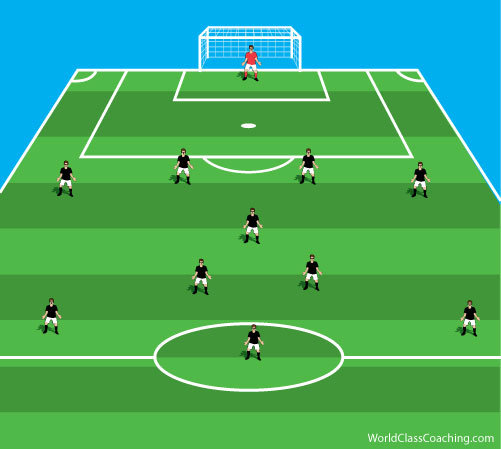
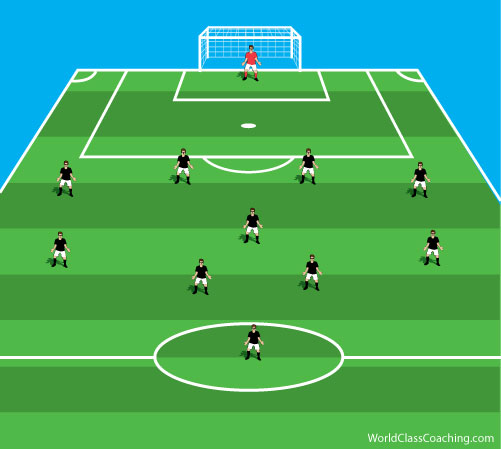
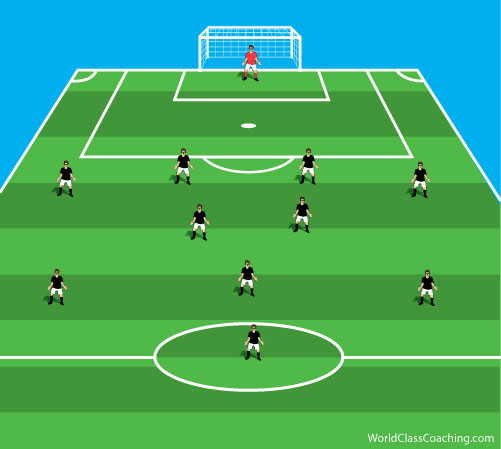

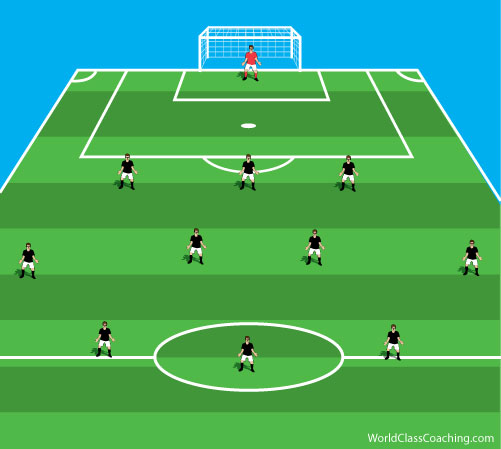
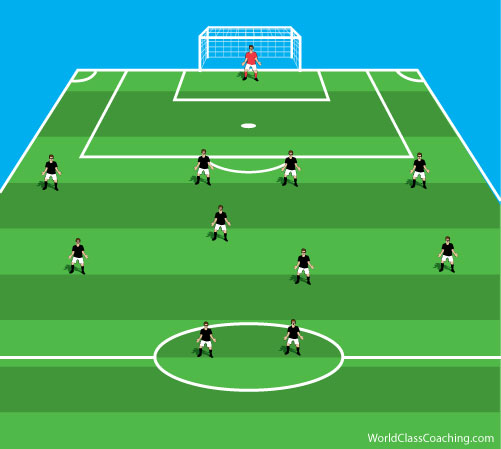
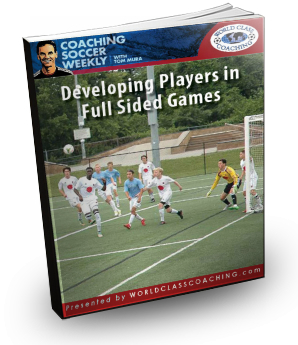
I coach U8. I would love to hear your thoughts on 4v4 formations and tactics.
I’ll put that down for a future episode. In the meantime, I would look at Futsal as a guide for how to organize for 4 v 4. With U8’s I would suggest keeping it simple and playing two defenders and two forwards. This is easy for them to understand and give them the basic idea. I will often describe the sides as ‘parents side’ and ‘coaches side’ rather than right and left. That helps them visualize it better. Then I would work on ball mastery and introduce the concepts of going away from pressure and into space both with and without the ball on offense and protecting the goal on defense. Keep it focused on fun and teaching them the techniques of dribbling (close control), running with the ball, passing and shooting. The most successful U8 coaches are the ones that have all their players come back for U9.
One more thing David..I would also suggest that you take the USSF ‘F’ License. It is only $25 and completed online. There is a link to their Digital Learning Center: https://dcc.ussoccer.com/courses/home/. I have had my ‘B’ License for many years but I took this course to learn what the latest best practices are. There is some great information there for coaches working with U8’s.
Really enjoy these presentations. I coach u11 boys and have focused on moving without the ball using these drills. Excellent.
Very concerned about age changes coming – seems aimed at very small group. Most kids play to have fun friends, seems counterintuitive to separate classmates.
Thanks Dave.
I think the change will be difficult for the first year. I wonder how many clubs/states will start this next year and how many wait until 2017.
Hi Tom
Thanks for the time and effort put into these pod casts; I’ve found them entertaining as well as thought provoking. In South Africa we play 9v9 between u10 and u12. Is there any chance you can offer some insight into different formations. Also, what, in your opinion, are the relative strengths and weaknesses of 8v8 compared to 9v9.
Thanks and regards
Clint
Clint,
It’s my pleasure. I enjoy putting the episodes together and I’m glad coaches find them interesting.
I think the one extra player allows you to have a balanced formation: 3-3-2. This gives plenty of defensive support/cover while also providing two forwards that can work together. You could also play 2-4-2 (with a midfield diamond), 3-1-3-1 or 4-3-1 but those all leave holes that can be exploited.
Tom,
Great content; the site and the podcasts. Very well done. Thanks.
Quick correction… 3-5-2 not 3-5-1 in the formation section header/title.
3-5-1
This is one of my favorite formations for young teams.
Rich,
Thanks, I’m glad you enjoy the podcast and the site.
I appreciate you pointing out the mistake so that I can correct it.